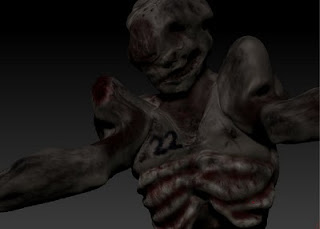I don't have to tell you that movies and games need audio effects and music to create a dramatic scene. Horror and thriller movies can't do without an angry synthesizer while that clumsy stupid woman is exploring that dark house with a kitchen knife, in her night-dress of course. When talking about game-programming, you probably think about graphics, but having a groovy sound is at least that important. Hence, I dare to say it might be even more important for some game genres. Cool graphics still fall when your monster moans like a little girlie. Some shooters completely fail just because the weaponry sound like an air pellet rifle. And even without much visuals you can still create a bone chilling climax when using the right eerie, psychedelic sound. Yet, strange enough games are rarely praised for having supreme audio. Probably because it’s less of a technical challenge. However, composing the right tunes is far from easy.
I'm afraid I won't be able to ship this movie with all the proper sound effects I would like to have, simply because I can't produce them myself. I can draw some textures, do models or even make a few (stiff) animations, but audio is a black hole. Except that we made some house music by recording farts and pasting them in a bouncing beat with Fruity Loops. Years ago. But that is not really going to help I guess. Another options is to browse the Internet. You can find quite a lot when browsing the web for free sounds, or even buy complete CD's with SFX for a reasonable price:
- http://www.flashkit.com/soundfx/
- http://www.findsounds.com/
But this scenery is so specific and based on dreamy unreal situations that the default sets of M16 gunfire, yelling grandma (CrazyRingtones®), Ferrari engine, sweet puppy barking, baby burps, or jackhammer & sweaty construction worker is not the stuff I need. I'm not much of a sound composer, but the things I have in mind are... how to explain it?
The environment has to play mind-tricks with you, so crazy ambient loops are key ingredients. The environment is silent and desolate, yet you hear lots of unexplainable, weird things. As if the building "talks". Getting mad of all those voices and chaos in your head and stuff. As for the monsters, I like them to shut up for a change. No catchy phrases such as "GRRR!!!", "AARH!", "See you in Hell!" or "Die!". The monsters aren't really mad at you to start with, so they just chatter unintelligible gibberish. If they make any sound at all. Maybe the best comparison might be the Silent Hill series. At least, that's what I would love to see, uhm, hear. But so far I'm completely dependent on whatever sound I can find.

A little bit difficult to post sound screenshots. So you'll have to do it with this... kitchen.
So, my best chance was having a peek into the Doom3 sound library. Hundreds of horrific ambient samples such as metal bending, demon computers, buzzing lights, monster moans, smooshy fleshy jerky sounds, evil praying monks, and so on. Now Doom3 is a lot more noisy and satanic than I’m aiming for, but there certainly are some cool effects to find here. The entire game is stuffed with threatening ambient loops, crazy machinery and other hellish sound. So I had a look in their *.PAK file. I know that is stealing, but I'm just an innocent boy, only playing, fingers crossed. Let's hope I can find a good sound engineer one day. But then again, how the hell can I attract a qualified boy/girl with a dull soundless movie? Precisely. Forgive me John Carmack & co. By the way, it Was Doom2 15 years ago which got me thinking about making games in the first place, so don't blame me :)
All in all, that was quite a different ride. After gathering a collection of (creepy) sounds, I started to write a storyboard. A sound storyboard I mean. Close your eyes and imagine walking your way through those hallways, then paste the right ambient loops or “shock” effects… Not easy! It's not just grabbing whatever sounds cool, the whole composition has to align. You can't mix Coldplay with Rammstein and Jive Jones either (please God no). Where is Mozart when you need him?

Serving cold beer right here. Or maybe better not. The reason why I posted on monday is, as usual, because of some epic hangover last weekend. Burp, think I feel it coming again...-running to the sink- -clattering sound effects, with meatballs-
Talking about sound & games.... Don't you guys miss some kick ass quality soundtracks in (action) games? Most games these days are merely using vague ambient background loops. That would include what I have in mind. Quite different from the catchy Super Mario tunes, the heavy metal tracks in Quake2 (Sonic Mayhem) or Carmageddon (Fear Factory). Spacy house music in Conquest Earth (Eat Static) or . Quite a pity. What is the first thing when you think about such games? Exactly, the music. Often annoying, but some are really qualitative. In fact, I have quite a lot of game MP3's in my WinAmp list. My absolute favourite game music?
- Command & Conquor / Red Alert (Frank Klepacki)
- Castlevania IV (snes). Really, for a cheesy 1-bit sound card, it is awesome classical music
- Crusader No Remorse (techno-house-rock made on a Commodore by Andrew Sega)
- Almost forgot, Little Big Planet. Makes me as happy as a baby
How about yours?











